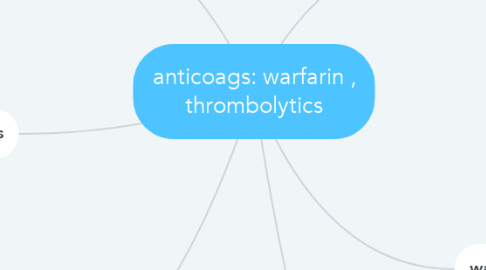anticoags: warfarin , thrombolytics
af Anneke Klomp


1. warfarin pt w/active bleeding
1.1. hospitalize and give vit k iv infusion w/ FFP or prothrombin complex concentrates (PCC) as needed; repeat INR in 12 hrs; repeat vit k as needed until INR in therapeutic range
2. thrombolytics
2.1. MOA: tissue plasminogen activator (tPA) binds to fibrin and activates plasminogen bound to fibrin
2.2. alteplase; reteplase; tenectaplase
2.2.1. given IV
2.2.2. acute MI w/STEMI and chest pain who presents w/in 12 hrs after onset
2.2.3. ischemic stroke onset of sxs w/in 3hrs
2.2.4. some cases of PE
2.2.5. improved patency and lower and lower 30day mortality rate
2.3. efficacy evaluated with chest pain, ECG, arrhythmias
3. thrombolytic absolue contraindications
3.1. previous hemorrhagic stroke
3.2. known intracranial bleeding
3.3. suspected aortic disection
3.4. active internal bleeding
4. warfarin
4.1. MOA: inhibits enzymes necessary for vit K activation in liver -> need for activation of vit K dependent factors formed in the liver
4.2. for prevention/tx of VTE; prevention embolic complications of Afib, heart valv replacement, complicated MI
4.3. target for warfarin: vit k epoxide reductase
4.4. indirect acting coag
4.5. variable dosing; delayed onset-> use bridge therapy: overlap w/ heparin until target INR
4.6. only first line drug for anticoags with valve repalcement and
5. warfarin AE
5.1. lotsa drug interactions; bleeding; purple toe syndrome (rare); skin necrosis in areas of subcutaneous fat (mc in women); GI; increased risk for osteoporosis (in longterm use)
5.2. food/drug interactions
5.2.1. increased vit k in diet decreases effectiveness; grapfruit products; drugs that increase bleeding risks (NSAIDS, antiplatelets, heparin
